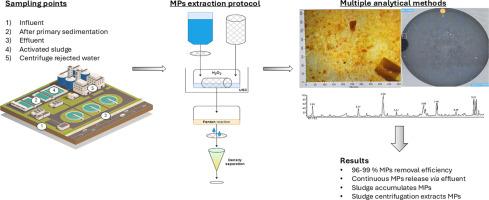Effectiveness of conventional municipal wastewater treatment plants in microplastics removal: Insights from multiple analytical techniques
IF 6.3
2区 环境科学与生态学
Q1 ENVIRONMENTAL SCIENCES
引用次数: 0
Abstract
This study investigated microplastics (MPs) sized 10–5000 µm across stages of a conventional municipal wastewater treatment plant using multiple analytical techniques. Samples were collected via pumping and filtration, treated with the Fenton reaction for wet peroxidation, and separated by density separation. Analysis employed Focal Plane Array Micro-Fourier Transform Infrared Spectroscopy (FPA micro-FTIR), a widely used technique in MPs analysis, alongside the less common Laser Direct Infrared Spectroscopy (LDIR), providing complementary data on particle composition, shape, size, and colour. To enhance insights, spectroscopic methods were supplemented with Thermal Desorption Gas Chromatography-Mass Spectrometry (TD-GC/MS), calibrated for specific polymers, to quantify MPs by mass and assess removal efficiency. Wastewater treatment effectively reduced MPs. In influent samples, concentrations reached 72 MPs/L (FTIR), 2117 MPs/L (LDIR), and 177 µg/L (TD-GC/MS). Primary treatments removed 41 %–55 %, while the wastewater treatment plant effluent contained 1 MPs/L (FTIR), 93 MPs/L (LDIR), and 2 µg/L (TD-GC/MS), reflecting 96 %–99 % removal efficiency. Activated sludge showed concentrations of 123 MPs/L (FTIR), 10,800 MPs/L (LDIR), and 0.3 mg/g dry weight (TD-GC/MS), underscoring its role in MPs capture. However, sludge dewatering released significant MPs into centrifuge rejected water: 484 MPs/L (FTIR), 23,000 MPs/L (LDIR), and 1100 µg/L (TD-GC/MS). These results highlight the effectiveness of conventional treatments in MPs removal and the critical role of sludge in capturing these contaminants. However, sludge dewatering poses a risk of reintroducing MPs into the environment. Effective sludge management should prioritize nutrient recovery and biomass valorisation to mitigate these risks and minimise harmful environmental impacts.

传统城市污水处理厂去除微塑料的有效性:来自多种分析技术的见解
本研究使用多种分析技术调查了传统城市污水处理厂各阶段10-5000µm的微塑料(MPs)。样品经泵送过滤后,经Fenton反应湿式过氧化处理,再经密度分离分离。分析采用焦平面阵列微傅立叶变换红外光谱(FPA微ftir),这是一种在MPs分析中广泛使用的技术,与不太常见的激光直接红外光谱(LDIR)一起,提供关于颗粒组成,形状,大小和颜色的补充数据。为了进一步深入了解,对光谱方法进行了补充,采用了针对特定聚合物进行校准的热解吸气相色谱-质谱法(TD-GC/MS),通过质量定量MPs并评估去除效率。废水处理有效地降低了MPs。在进水样品中,浓度达到72 MPs/L (FTIR), 2117 MPs/L (LDIR)和177µg/L (TD-GC/MS)。初级处理的去除率为41% - 55%,而污水处理厂流出物的去除率为1 MPs/L (FTIR), 93 MPs/L (LDIR)和2µg/L (TD-GC/MS),去除率为96% - 99%。活性污泥的浓度为123 MPs/L (FTIR), 10,800 MPs/L (LDIR), 0.3 mg/g干重(TD-GC/MS),强调了其在MPs捕获中的作用。然而,污泥脱水向离心废液中释放了大量MPs: 484 MPs/L (FTIR), 23,000 MPs/L (LDIR)和1100µg/L (TD-GC/MS)。这些结果强调了常规处理在去除MPs方面的有效性以及污泥在捕获这些污染物方面的关键作用。然而,污泥脱水带来了将MPs重新引入环境的风险。有效的污泥管理应优先考虑养分回收和生物质增值,以减轻这些风险,并尽量减少对环境的有害影响。
本文章由计算机程序翻译,如有差异,请以英文原文为准。
求助全文
约1分钟内获得全文
求助全文
来源期刊

Journal of Environmental Sciences-china
环境科学-环境科学
CiteScore
13.70
自引率
0.00%
发文量
6354
审稿时长
2.6 months
期刊介绍:
The Journal of Environmental Sciences is an international journal started in 1989. The journal is devoted to publish original, peer-reviewed research papers on main aspects of environmental sciences, such as environmental chemistry, environmental biology, ecology, geosciences and environmental physics. Appropriate subjects include basic and applied research on atmospheric, terrestrial and aquatic environments, pollution control and abatement technology, conservation of natural resources, environmental health and toxicology. Announcements of international environmental science meetings and other recent information are also included.
 求助内容:
求助内容: 应助结果提醒方式:
应助结果提醒方式:


